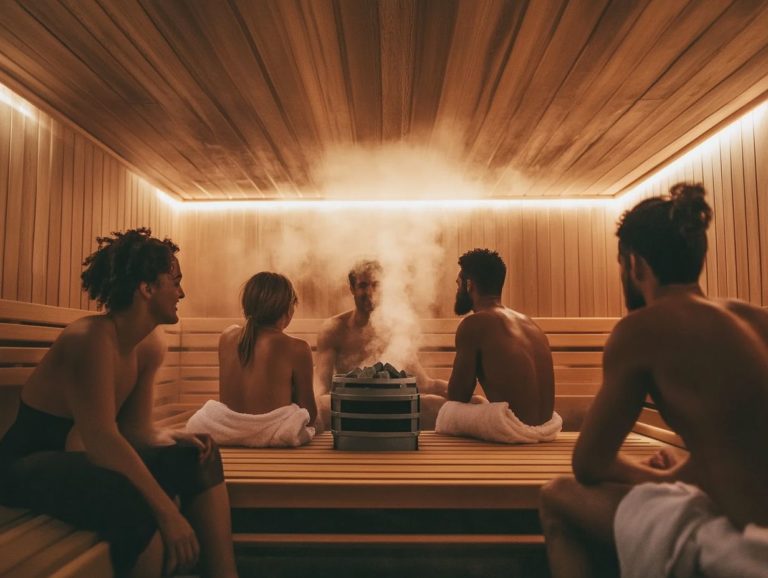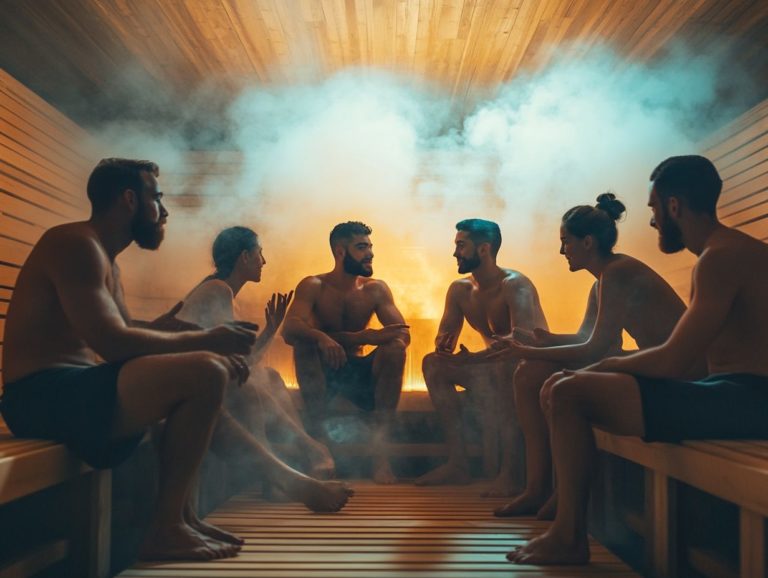Sauna Safety: The Importance of Inclusion
Saunas present a remarkable fusion of relaxation and health benefits. Prioritizing safety while enjoying them is essential for everyone.
This article delves into the essence of saunas and their functioning. It highlights the importance of creating inclusive sauna environments for all individuals. Specific safety considerations tailored for diverse groups, including people with disabilities, pregnant women, children, and the elderly are addressed.
You ll find practical tips for a safe sauna experience. These empower you to engage in this soothing ritual with complete confidence.
Contents
- Key Takeaways:
- Understanding Sauna Safety
- The Importance of Inclusion in Sauna Use
- Benefits of Inclusive Sauna Spaces
- Sauna Safety for Individuals with Disabilities
- Sauna Safety for Pregnant Women
- Sauna Safety for Children
- Sauna Safety for Elderly Individuals
- Tips for Sauna Safety
- Frequently Asked Questions
- What is sauna safety and why is inclusion important?
- How can sauna owners promote inclusion and safety in their facilities?
- What are some potential risks or dangers in a sauna and how can they be prevented?
- Are there any precautions for those with existing health issues before using a sauna?
- Is it safe to use a sauna while pregnant?
- How can I help create a safe and welcoming environment in the sauna for everyone?
Key Takeaways:

- Saunas can provide numerous health benefits, but it is important to understand the potential risks and take necessary precautions.
- Inclusive sauna spaces promote diversity and accessibility, allowing people of all abilities and backgrounds to enjoy the benefits of sauna use.
- Special considerations and accommodations should be made for people with disabilities, pregnant women, children, and elderly individuals to ensure their safety while using a sauna.
Understanding Sauna Safety
Understanding sauna safety is crucial. It helps you enjoy health benefits while minimizing risks. Saunas have gained a well-deserved reputation for offering relaxation and therapeutic effects, playing a significant role in enhancing your overall wellness routine.
To ensure a safe sauna experience, familiarize yourself with various factors. This includes the different types of saunas like traditional and infrared as well as recommended session durations and your individual health conditions.
It s wise to consult a healthcare provider to better understand your personal health limitations. This helps in making informed decisions about your sauna bathing practices and the associated heart health advantages.
What is a Sauna and How Does it Work?
A sauna is your personal escape, a cozy space designed for indulgent heat sessions. Saunas typically fall into two categories: the traditional sauna and the infrared sauna. Each offers unique benefits that elevate your wellness experience.
In the traditional sauna, usually heated by wood or electric stoves, the air temperature rises dramatically. This envelops you in a wave of warmth that encourages your body to sweat profusely. This delightful sweating mechanism acts as a natural detox, flushing out toxins while boosting your heart rate and enhancing blood circulation.
Conversely, the infrared sauna uses infrared heaters to warm your body directly. This occurs without dramatically increasing the air temperature, allowing you to enjoy a comfortable yet effective sweating experience.
Both types not only promote relaxation and stress reduction but also contribute to improved cardiovascular health. They potentially enhance your endurance and recovery. Embrace the heat and let it work wonders for your well-being.
The Importance of Inclusion in Sauna Use
Incorporating sauna use into your wellness routine is essential. It opens the door for individuals from all walks of life and varying health conditions to enjoy the myriad benefits of sauna bathing.
From alleviating stress to enhancing cardiovascular health, the advantages of this practice are profound and accessible to everyone.
Benefits of Inclusive Sauna Spaces
Inclusive sauna spaces offer a wealth of health benefits that can significantly elevate your wellness routine, especially if you re dealing with various health conditions. They create an environment that promotes relaxation and helps alleviate chronic fatigue.
These thoughtfully designed spaces are tailored to accommodate a diverse audience, ensuring accessibility for everyone, including those with mobility challenges. If you have arthritis, the warm, soothing air can work wonders by reducing joint stiffness and enhancing flexibility.
For those grappling with mental health issues, including dementia or Alzheimer’s disease, the serene atmosphere fosters mindfulness and offers a much-needed respite from daily stress.
If you’re caring for someone with dementia, the calming sanctuary of the sauna can enhance social interaction and provide a rich sensory experience that promotes overall well-being. By addressing these diverse needs, inclusive sauna spaces become invaluable for anyone in search of both physical comfort and mental clarity. Understanding sauna safety and the importance of connection is crucial for maximizing these benefits.
Sauna Safety for Individuals with Disabilities

Sauna safety for individuals with disabilities is of utmost importance. This allows everyone to experience the therapeutic benefits of using the sauna while carefully considering their specific health conditions and needs, particularly in managing chronic pain.
Accommodations and Precautions
When you decide to use a sauna, it’s important to consider specific accommodations and precautions to ensure a safe and enjoyable experience, especially if you have a disability. Prioritizing wheelchair accessibility can make entering and exiting the sauna much smoother.
It’s crucial to maintain a comfortable temperature; starting at a lower heat setting allows you to gauge how your body reacts. Monitor your comfort level throughout the session to prevent overheating or any discomfort.
Don t forget to take breaks to hydrate, as staying cool and hydrated is particularly important. Most importantly, consult a healthcare provider beforehand. They can provide tailored advice based on your individual health conditions and needs, enhancing both your safety and enjoyment.
Sauna Safety for Pregnant Women
In terms of sauna safety for pregnant women, it’s essential to be mindful of several considerations. Elevated body temperatures and dehydration can present serious health risks for both mother and child during sauna use.
Safety is crucial in this calm environment for ensuring a healthy experience, particularly for those with medical conditions.
Considerations and Precautions
When considering sauna use, it’s essential for pregnant women to take necessary precautions to minimize risks associated with heat and dehydration, ensuring a safe experience. Limiting sauna sessions to brief durations, typically no longer than 10-15 minutes, is advisable to prevent overheating.
Opting for infrared saunas might be a smarter choice, as they generally operate at lower temperatures while still delivering the desired benefits. Staying well-hydrated before and after your sauna session is crucial, since dehydration can pose significant risks during pregnancy. Additionally, understanding sauna safety is essential to ensuring a safe and enjoyable experience.
Always consult a healthcare provider. They can offer tailored advice to meet individual health needs and conditions, ensuring that your sauna experience remains both enjoyable and safe. For more information, check out sauna safety and the importance of consultation.
Sauna Safety for Children
Sauna safety for children is paramount, given their heightened sensitivity to heat and risk of dehydration. Follow these simple guidelines for a safe sauna experience, and provide vigilant supervision to guarantee a safe and enjoyable sauna experience for them.
Ready to experience these benefits? Find your nearest inclusive sauna today!
Guidelines and Supervision

To ensure a safe sauna experience for children, you must establish clear guidelines and maintain proper supervision to mitigate the health risks associated with sauna bathing.
Setting time limits is vital; consider starting with a duration of around 5 to 10 minutes for younger users. Gradually increase this as they become more accustomed to the heat. Keep the temperature mild for maximum comfort and fun, ideally between 70 to 80 degrees Celsius. Stay vigilant for any signs of discomfort, such as excessive sweating, flushed skin, or fatigue, to guarantee a positive experience for your child. Additionally, understanding sauna safety and positivity can enhance their enjoyment.
Encourage hydration before and after the sessions, as children are particularly susceptible to dehydration. For further insights on maintaining a safer environment, ensure proper ventilation to promote air circulation, creating a safer environment for everyone present.
Sauna Safety for Elderly Individuals
Elderly individuals must prioritize sauna safety, as they often encounter unique health conditions that necessitate specific precautions. Taking the right measures ensures that they can enjoy a safe and beneficial sauna experience tailored to their needs.
Precautions and Recommendations
Elderly individuals should embrace specific precautions and recommendations when using a sauna to reduce health risks tied to age-related conditions such as arthritis or fibromyalgia.
To ensure a safe and enjoyable experience, it’s wise to start with shorter sessions, allowing your body to acclimatize gradually to the heat. Regularly monitoring your body temperature can help prevent overheating, especially if you have any health concerns. For comprehensive guidance, understanding the importance of sauna safety training is essential.
Staying hydrated is essential. Make it a habit to drink water before and after your time in the sauna to effectively replenish fluids lost through sweating. Consulting with healthcare providers can offer personalized advice tailored to your health status and help you decide about sauna use, ensuring your well-being throughout the experience. Additionally, understanding sauna safety can enhance your personal growth during these sessions.
Tips for Sauna Safety
Implementing effective sauna tips for sauna safety allows you to enjoy a truly rewarding experience while fully maximizing the myriad health benefits that sauna use offers, including stress relief and enhanced cardiovascular health, especially for those with high blood pressure.
Best Practices for a Safe Sauna Experience
Adhering to best practices for a safe sauna experience can significantly elevate the health benefits you reap from sauna bathing, including relaxation and detoxification (the process of removing toxins from the body).
To fully enjoy these advantages, prioritize hydration, as your body loses fluids rapidly in high temperatures. It’s also crucial to be aware of your personal body temperature limits to prevent overheating. For more information on staying safe, consider reviewing sauna safety: understanding your limits. Selecting the right type of sauna, be it traditional, infrared, or steam, can further customize your experience to align with your specific health goals.
Incorporating effective cool-down methods, such as gentle stretching or a quick shower after your session, will help your body return to equilibrium. This promotes overall well-being and maximizes the therapeutic effects of this age-old practice.
Frequently Asked Questions

What is sauna safety and why is inclusion important?
A sauna is a small room used for dry or wet heat sessions. Sauna safety refers to the measures taken to ensure a safe and enjoyable experience in a sauna, while inclusion refers to creating an environment that welcomes and accommodates individuals from all backgrounds and abilities. It is important because everyone should have equal access and feel comfortable using saunas.
How can sauna owners promote inclusion and safety in their facilities?
To promote inclusion and safety in saunas, owners can train their staff on diversity and sensitivity, provide accessible facilities for individuals with disabilities, and have clear rules and regulations posted for all to follow.
What are some potential risks or dangers in a sauna and how can they be prevented?
Some potential risks in saunas include overheating, dehydration, and slips and falls. These can be prevented by setting a timer for sauna sessions, staying hydrated, and ensuring the sauna is clean and free of wet floors.
Don t wait start implementing these safety tips today! Share your sauna experiences below to help create a community focused on well-being.
Are there any precautions for those with existing health issues before using a sauna?
If you have health issues, consult a healthcare professional before using a sauna.
Start with short sessions to avoid overdoing it.
Is it safe to use a sauna while pregnant?
Pregnant women should generally avoid saunas.
High heat can be risky for the developing baby, so get personalized advice from a healthcare professional.
How can I help create a safe and welcoming environment in the sauna for everyone?
Create a safe sauna environment by respecting others’ space and boundaries.
Report any concerns to the staff. Learn about diversity and inclusion to help everyone feel welcome.






